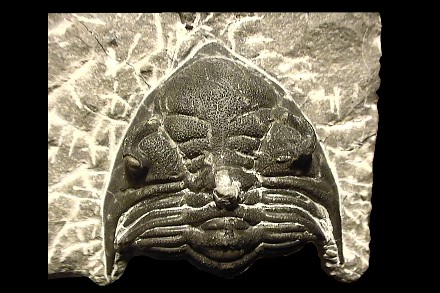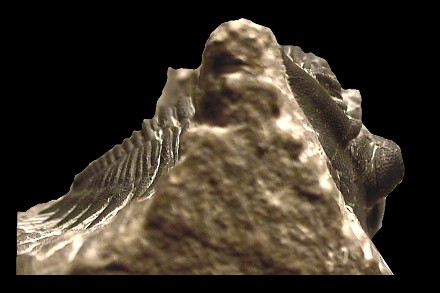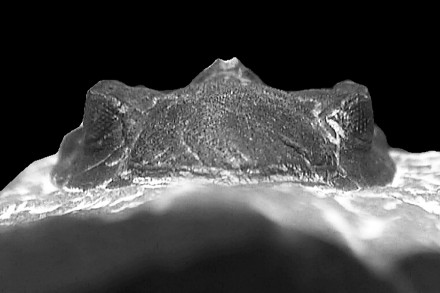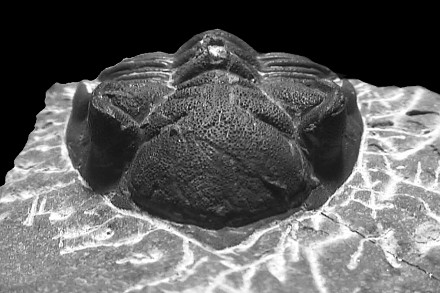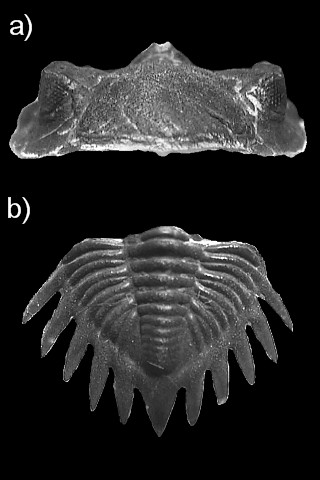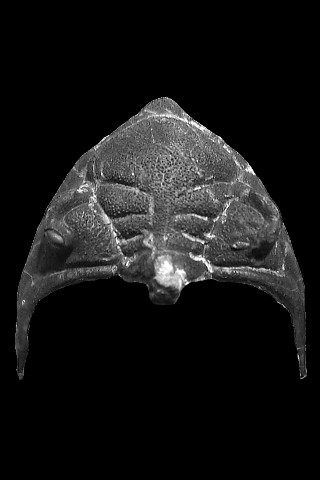Moroccan Devonian Trilobite, here is a specimen which diagnosis was made by
P. Morzadec, 2001, in a publication that marked an important step in trilobite
knowledge for all moroccan trilobite lovers :) The genus Metacanthina has,
in Morocco, 3 species at least : Metacanthina issoumourensis MORZADEC
2001, Metacanthina maderensis MORZADEC 2001
and Metacanthina wallacei (G. & H. TERMIER
1950).
|
Order
|
Phacopida
|
SALTER 1864
|
Occurrence: Lower Ordovician (Tremadoc) to Upper Devonian (Famennian).
- Cephalon: Proparian (Phacopina and Cheirurina), gonatoparian
(Calymenina) or opisthoparian (Calymenina),
- Preglabellar field often very short or absent.
- 4 or fewer pairs of glabellar furrows.
- Eyes : when present, schizochroal (Phacopina) or holochroal (Cheirurina
and Calymenina).
- With rostral plates (Calymenina and Cheirurina) or without (some
Phacopina).
- Hypostome conterminant (all suborders) to impendent (some devonian
Phacopina).
- Exosqueletton generally granulous.
- Thorax: 8 – 19 segments, sometimes distinctly furrowed.
- Axis sometimes broad (e.g., Homalonotidae).
- Pygidium : Typically micropygous (most Calymenina and Phacopina),
but variable (e.g., subisopygous in Dalmanitoidea and Acastoidea).
- May be lobed or spiny (e.g., Cheirurina, some Dalmanitoidea, Acastoidea),
or smooth-margined, with round or subtriangular outline (e.g., Calymenina,
Phacopoidea).
|
|
Sub-order
|
Phacopina
|
STRUVE 1959
|
- Cephalon : Proparian sutures (sometimes fused).
- Schizochroal eyes.
- Glabella expands forwards.
- Librigena typically yoked as single piece.
- Hypostome conterminant to impendent, some with no rostral plate.
- Some with genal spines.
- Thorax: 10 to (typically) 11 segments.
- Pleurae furrowed, articulating facets distinct.
- Rounded, angular, or spinose tips.
- Pygidium : Typically smaller than cephalon (but subisopygous
in Dalmanitoidea and Acastoidea).
- Smooth or spinose.
|
|
Super-family
|
Acastoiedea
|
DELO 1935
|
- Cephalon : Axial furrows slightly to moderately divergent.
- Anterior glabellar lobes and furrows usually not fused (although furrows
may be indistinct).
- Eyes typically distant from posterior border furrows, but not strongly
anterior.
- Frontal glabellar lobe auxilliary impression system triangular in
outline.
- Maximum width of glabella adjacent to preglabellar furrow.
- Median region of glabella devoid of muscle scars.
- Cephalic margin "shouldered".
- Laterally convex course of genal margin topographically distinct from
curvature of axial margin.
- Thorax : Pleural endings blunt, rounded or angular.
- Sometimes spinose.
- Pygidium : Micropygous to subisopygous.
- Sometimes spinose (expressed as marginal spines).
- Pygidial axis with deep, apodemal anterior ring furrows, with abrupt
transition to shallow posterior ring furrows.
- Coincident decrease in angle of axial furrow convergence.
|
|
Family
|
Acastidae
|
EDGECOMBE 1993
|
- Cephalon : Semi-circular to rounded subtriangular.
- Cephalic border narrow in front of the glabella.
- Dorsal furrows slilghtly to moderately divergent.
- Anterior glabellar furrows (S3) simple.
- Medial furrows (S2) moderately deep.
- Deep posterior furrows (S1).
- L2 and L3 lateral glabellar lobes generally fused distally.
- Muscle scars bearing sometimes callosities (Acastinae).
- Eyes typically distant from the posterior genal furrows.
- Hypostoma
- Pygidium : micropygous to subisopygous.
- Semi-circular to rounded subtriangular.
- Short posterior spine present.
|
|
Sub-family
|
Asteropyginae |
DELO 1935
|
Traditionnally included in the Dalmanitidae, Asteropyginae are now included
in the Acastids. Mostly benthic trilobites.
- Cephalon : Closely similar to the Dalamanatid Dalmanitides
BARRANDE 1853.
- Glabella expanding forward.
- 3 lateral glabellar furrows.
- Eyes generally large.
- Genal angles acutely pointed or bearing medium-length to very long
genal spines in straight continuation of lateral margins.
- Pygidium : Rachis never reaching the posterior region of the
pygidial border.
- Generally 5 pairs of lateral spines (sometimes 4 or 6).
- Unpaired posterior lappet or spine.
|
|
Genus
|
Metacanthina
|
PILLET 1954
|
- Cephalon : Anterior border distinct.
- Preglabellar area developped
- Frontal lobe slightly widening.
- Eyes sometimes fairly developped and distant from the posterior furrow
of the Librigenæ.
- Librigenæ somewhat flat.
- Long genal spines.
- Pygidium : Many axial rings.
- Pleural segmentation type internmediate between boothi and
prorotundifrons.
- Lateral genal spines long, flattened and falciform.
- Median spine triangular and lanceolated.
|
|
Species
|
issoumourensis
|
MORZADEC 2001
|
Metacanthina species characterized by a very granulous exosqueletton.
- Cephalon : Small flat tongue in front of the cephalon.
- Occipital spine.
- Pygidium : 5 pairs of pleural ribs.
- Median spine broad at its basis, hardly longer than the 5th pair of
lateral spines.
|
The high number of rachis rings and of pleural ribs, as the strong granulation
on the exosqueletton make from Metacanthina issoumourensis a very distant
relative of the iberian species Metacanthina aequisulcata GANDL
1972 or the turkish species Metacanthina asiatica (VERNEUIL
1866).
